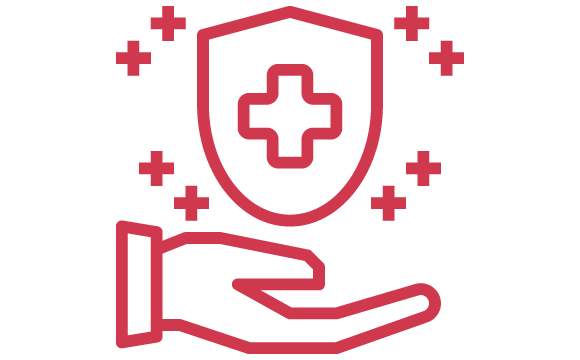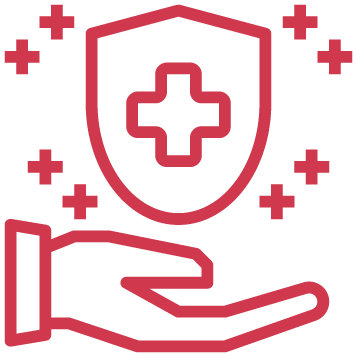Occupational Health Safety & Environment (OHS&E)
Department of OHS&E manages a suite of resources to help the hospital assess workplace safety needs, implement safety and health management systems, and enhance safe patient handling programs. The department offers a complete range of onsite environmental services including waste collection, internal waste transfer, EHS inspections, and chemical inventory management.
Hospitals have serious hazards, including: needle stick injuries, blood borne pathogens, fall injuries, lifting, transferring, and repositioning patients, waste management and many other concerns, therefore department of OHS&E with its dedicated and professional team is working hard on providing services which will help in providing a safe and healthier environment to patients, staff and visitors.
3.1 Fire Safety
Various precautionary measures have been adopted to ensure fire safety, including the installation of smoke detectors, placement of fire extinguishers and fire hoses at appropriate locations. Furthermore, relevant trainings have been provided to the staff members and Fire mock drills are conducted with the assistance of rescue 1122. To educate the public, signage are displayed describing actions to take in case of a fire incident.
3.2 Emergency Preparedness & Evacuation
Standard operating procedures have been established and relevant training is being given to staff on responding to emergency situations, including chemical spill, bomb threat, gas leak and other external and internal emergencies. Dedicated emergency evacuation routes (Exits) signage and LED Lights are displayed at each floor to facilitate safe evacuation to the pre-determined assembly point.
3.3 Infection Control
The spread of infection in this hospital is controlled through proper hand hygiene performed by staff, use of PPEs, waste segregation and environmental cleaning. Furthermore, negative pressure ventilation systems have been installed in critical areas and some wards, where patients with contagious disease are isolated.
3.3.1 Isolation of Patient’s in a Single Room
Patients with contagious diseases are isolated in rooms with negative pressure ventilation and the concerned staff members alerted to prevent the spread of infections.
3.3.2 Hand Washing /Hand Rub
Staff are specifically trained on hand-washing since hands are one of the most common vehicles of infection transfer in healthcare settings. Staff are advised that hands should be regularly washed with soap or using a hand sanitizer with alcohol content between 60 to 90%.
3.3.3 Use of mask and Protective Eye Wear
Staff are also trained that in order to protect the mucous membrane of nose and mouth from exposure to droplets of bodily fluids or other such harmful substances, it is essential that mask must be worn. Protective eye wear, such as goggles and face shield, is used when the risk of exposure is to eyes from the splatters or droplets of any infectious/hazardous substance.
3.3.4 Use of Gowns and Plastic Aprons
It is ensured that gowns must be worn in situations that carry risk of occupational exposure to bodily fluids, chemicals or other such substances.
3.3.5 Use of Gloves
The use of gloves is highly advised and monitored, to protect not only the staff members from communicable diseases but also the patients, by limiting the transfer of endogenous microbial flora. Gloves are also used by the housekeeping and other concerned staff during environmental clean-up.
3.3.6 Safe Handling of Contaminated Linen
Used linen is placed in hamper bags to be handled as little as possible by the concerned staff members in order to avoid cross contamination.
3.3.7 Safe Management of Contaminated Sharps
Since prick injuries can result in the transfer of infections, guidelines have been established for the proper disposal of sharps, such as needles, in puncture proof containers.
3.3.8 Post exposure management of health care workers exposed to blood and body fluids
Staff are trained that occupational exposure to bodily fluids should be reported to the concerned supervisor as soon as possible and to follow the instruction of the concerned healthcare provider.
3.3.9 Prevention of Blood-borne viruses
The occurrence of resistant bugs has increased over the years due to improper use of various antibiotics. In order to limit their transfer in hospitals, environmental cleaning and hand hygiene along with the use of appropriate PPEs is of due concern. Furthermore, patients with such infections are isolated in separate rooms with minimum visitors.
3.3.10 Management of COVID-19 Patients
As per the guidelines established by the hospital, patients suffering from COVID-19 are isolated in wards with negative pressure ventilation. Access to such locations is only provided to the healthcare providers, attendants and other staff members after donning proper PPE. If a patient tests positive in wards/rooms/critical areas/units, that specific location is fumigated after patient transfer to the COVID ward.
3.3.11 Operating procedure for Viral Haemorrhagic Fevers
According to the hospital policy, patients suffering from viral haemorrhagic fevers, suspected or confirmed cases, will be isolated. The staff members attending such patients would take all the necessary precautionary measures. All items from such isolation rooms would be considered infectious and treated as such i.e. incinerated.
3.4 Hospital Waste Management
Solid waste generated in the hospital is segregated into three color-coded bins: white bins for general or non-infected waste, red bins for cytotoxic waste and yellow bins for infectious waste. Additionally glass waste (broken glass, ampules and vials) is disposed in a separate puncture and leak proof container, while sharps (needles, blades etc.) are discarded in a puncture proof safety box.
3.5 Pest Control
Since pests serve as vector for disease transfer in human beings, measures have been taken for their control. Insect light traps have been placed at the entrance in each ward, critical area, operation theatre and other such locations. Regular fumigation is another process through which the prevalence of pests is controlled.
3.6 Environmental Cleaning & Disinfection
Dust is home to a large number of microbes, therefore the hospital environment is kept as clean as possible. Special attention is given to horizontal surfaces at all locations, especially critical units and operation theatre. After cleaning the surfaces are washed through surface disinfectants.
3.7 Drinking Water Quality Analysis
Drinking water supplies of the NWGH, NWTH, NWSM and Hostels is tested quarterly for determining the physical (turbidity and total suspended solids), chemical (nutrients) and biological (microorganisms) parameters for quality assurance and safety of the staff, patients and attendants.



